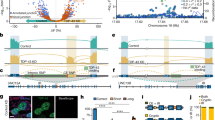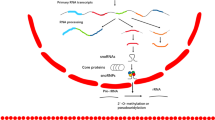Abstract
Ubiquilin1 (UBQLN1) is a ubiquitin-like domain and a ubiquitin-associated domain containing protein that has been reported to be involved in shuttling proteins to the proteasome, especially during endoplasmic reticulum-associated protein degradation. Thus, UBQLN1 function has been shown to be critical for combating a number of neurological disorders caused by protein aggregation, such as amyotrophic lateral sclerosis, Alzheimer’s disease and Huntington’s disease. A role for UBQLN1 in regulating processes involved in tumorigenesis has not been demonstrated. Herein, we show that loss of UBQLN1 causes increased cell migration and invasion, actin cytoskeleton reorganization and induction of epithelial-to-mesenchymal transition (EMT). Loss of UBQLN1 results in a significant decrease in the expression of epithelial markers including E-cadherin and claudin1, whereas expression of mesenchymal markers including Vimentin, Snail and ZEB1 are significantly elevated. Interestingly, we found that ZEB1 is required for induction of mesenchymal-like properties following loss of UBQLN1 and ZEB1 is capable of repressing expression of UBQLN1, suggesting a physiological, reciprocal regulation of EMT by UBQLN1 and ZEB1. Further, we find evidence for a role for UBQLN2 in also regulating EMT and cell migration. These observations have potential clinical relevance because the UBQLN1 gene is lost and underexpressed in a large percentage of human cancer cell lines, and primary human lung cancer samples and recurrent mutations in all five UBQLN family members have been identified in human lung cancers. Taken together, our results suggest for the first time a role for UBQLN family members in cancer biology.
This is a preview of subscription content, access via your institution
Access options
Subscribe to this journal
Receive 50 print issues and online access
$259.00 per year
only $5.18 per issue
Buy this article
- Purchase on Springer Link
- Instant access to full article PDF
Prices may be subject to local taxes which are calculated during checkout







Similar content being viewed by others
References
Lim PJ, Danner R, Liang J, Doong H, Harman C, Srinivasan D et al. Ubiquilin and p97/VCP bind erasin, forming a complex involved in ERAD. J Cell Biol 2009; 187: 201–217.
Lu A, Hiltunen M, Romano DM, Soininen H, Hyman BT, Bertram L et al. Effects of ubiquilin 1 on the unfolded protein response. J Mol Neurosci 2009; 38: 19–30.
Kim H, Kim HY, Choi MR, Hwang S, Nam KH, Kim HC et al. Potentiation of amyotrophic lateral sclerosis (ALS)-associated TDP-43 aggregation by the proteasome-targeting factor, ubiquilin 1. J Biol Chem 2009; 284: 8083–8092.
Arias-Vásquez A, de Lau L, Pardo L, Liu F, Feng BJ, Bertoli-Avella A et al. Relationship of the ubiquilin 1 gene with Alzheimer's and Parkinson's disease and cognitive function. Neurosci Lett 2007; 424: 1–5.
Olzmann JA, Li L, Chin LS . Aggresome formation and neurodegenerative diseases: therapeutic implications. Curr Med Chem 2008; 15: 47–60.
Rutherford NJ, Lewis J, Clippinger AK, Thomas MA, Adamson J, Cruz PE et al. Unbiased screen reveals ubiquilin-1 and -2 highly associated with huntingtin inclusions. Brain Res 2013; 1524: 62–73.
Beverly LJ, Lockwood WW, Shah PP, Erdjument-Bromage H, Varmus H . Ubiquitination, localization, and stability of an anti-apoptotic BCL2-like protein, BCL2L10/BCLb, are regulated by ubiquilin1. Proc Natl Acad Sci USA 2012; 109: E119–E126.
Chen G, Wang X, Yu J, Varambally S, Yu J, Thomas DG et al. Autoantibody profiles reveal ubiquilin 1 as a humoral immune response target in lung adenocarcinoma. Cancer Res 2007; 67: 3461–3467.
Kalluri R, Weinberg RA . The basics of epithelial-mesenchymal transition. J Clin Invest 2009; 119: 1420–1428.
Thiery JP, Acloque H, Huang RY, Nieto MA . Epithelial-mesenchymal transitions in development and disease. Cell 2009; 139: 871–890.
Zeisberg M, Neilson EG . Biomarkers for epithelial-mesenchymal transitions. J Clin Invest 2009; 119: 1429–1437.
Iwatsuki M, Mimori K, Yokobori T, Ishi H, Beppu T, Nakamori S et al. Epithelial-mesenchymal transition in cancer development and its clinical significance. Cancer Sci 2010; 101: 293–299.
Liu Y . New insights into epithelial-mesenchymal transition in kidney fibrosis. J Am Soc Nephrol 2010; 21: 212–222.
Lilley BN, Ploegh HL . A membrane protein required for dislocation of misfolded proteins from the ER. Nature 2004; 429: 834–840.
Wójcik C, Rowicka M, Kudlicki A, Nowis D, McConnell E, Kujawa M et al. Valosin-containing protein (p97) Is a regulator of endoplasmic reticulum stress and of the degradation of N-end rule and ubiquitin-fusion degradation pathway substrates in mammalian cells. Mol Biol Cell 2006; 17: 4606–4618.
Bevilacqua E, Wang X, Majumder M, Gaccioli F, Yuan CL, Wang C et al. eIF2-α phosphorylation tips the balance to apoptosis during osmotic stress. J Biol Chem 2010; 285: 17098–17111.
Wang Q, Li L, Ye Y . Regulation of retrotranslocation by p97-associated deubiquitinating enzyme ataxin-3. J Biol Chem 2006; 174: 963–971.
Soetandyo N, Wang Q, Ye Y, Li L . Role of intramembrane charged residues in the quality control of unassembled T-cell receptor alpha-chains at the endoplasmic reticulum. J Cell Sci 2010; 123: 1031–1038.
Etienne-Manneville S, Hall A . Rho GTPases in cell biology. Nature 2002; 420: 629–635.
Shah PP, Fong MY, Kakar SS . PTTG induces EMT through integrin αVβ3-focal adhesion kinase signaling in lung cancer cells. Oncogene 2011; 31: 3124–3135.
Oyanagi J, Ogawa T, Sato H, Higashi S, Miyazaki K . Epithelial-mesenchymal transition stimulates human cancer cells to extend microtubule-based invasive protrusions and suppresses cell growth in collagen gel. PLoS ONE 2012; 7: e53209.
Grooteclaes ML, Frisch SM . Evidence for a function of CtBP in epithelial gene regulation and anoikis. Oncogene 2000; 19: 3823–3828.
Thiery JP . Epithelial-mesenchymal transitions in development and pathologies. Curr Opin Cell Biol 2003; 15: 740–746.
Acloque H, Adams MS, Fishwick K, Bronner-Fraser M, Nieto MA . Epithelial–mesenchymal transitions: the importance of changing cell state in development and disease. J Clin Invest 2009; 119: 1438–1449.
Nurwidya F, Takahashi F, Murakami A, Takahashi K . Epithelial mesenchymal transition in drug resistance and metastasis of lung cancer. Cancer Res Treat 2012; 244: 151–156.
Keshamouni VG, Michailidis G, Grasso CS, Anthwal S, Strahler JR, Walker A et al. Differential protein expression profiling by iTRAQ-2DLC-MS/MS of lung cancer cells undergoing epithelial-mesenchymal transition reveals a migratory/invasive phenotype. J Proteome Res 2006; 5: 1143–1154.
Christiansen JJ, Rajasekaran AK . Reassessing epithelial to mesenchymal transition as a prerequisite for carcinoma invasion and metastasis. Cancer Res 2006; 66: 8319–8326.
Vandewalle C, Van Royb F, Berxa G . The role of the ZEB family of transcription factors in development and disease. Cell Mol Life Sci 2009; 66: 773–787.
Dohadwala M, Yang SC, Luo J, Sharma S, Batra RK, Huang M et al. Cyclooxygenase-2-dependent regulation of E-cadherin: rostaglandin E(2) induces transcriptional repressors ZEB1 and snail in non-small cell lung cancer. Cancer Res 2006; 66: 5338–5345.
Zhang GJ, Zhou T, Tian HP, Liu ZL, Xia SS . High expression of ZEB1 correlates with liver metastasis and poor prognosis in colorectal cancer. Oncol Lett 2013; 5: 564–568.
Shen A, Zhang Y, Yang H, Xu R, Huang G . Overexpression of ZEB1 relates to metastasis and invasion in osteosarcoma. J Surg Oncol 2012; 105: 830–834.
Kamiya T, Obara A, Hara H, Inagaki N, Adachi T . ER stress inducer, thapsigargin, decreases extracellular-superoxide dismutase through MEK/ERK signaling cascades in COS7 cells. Free Radical Res 2011; 45: 692–698.
Acknowledgements
We thank Lavona Casson and current members of the Beverly lab for technical assistance and Dr Mohammad T Malik for valuable comments, discussion and technical advice. We would like to thank Douglas Darling for the gift of the ZEB1 antibody. The work was supported by the start-up funds from James Graham Brown Cancer Center, University of Louisville and Kosair Pediatric Cancer Program and Molecular Targets COBRE 8P20GM103482-10 from NIH, an award from the Lung Cancer Research Foundation to LJB, an award from the Rounsavall Foundation to LJB, an award from the Wendy Will Case Cancer Fund to LJB, R25-CA-134283 from the National Cancer Institute to SPS. Part of this work was performed with assistance of the UofL Genomics Facility, which is supported by NIH/NIGMS Phase III COBRE 1P30 GM106396-01, NIH/NIGMS KY-INBRE P20GM103436, the James Graham Brown Foundation, and user fees.
Author information
Authors and Affiliations
Corresponding author
Ethics declarations
Competing interests
The authors declare no conflict of interest.
Additional information
Supplementary Information accompanies this paper on the Oncogene website
Rights and permissions
About this article
Cite this article
Shah, P., Lockwood, W., Saurabh, K. et al. Ubiquilin1 represses migration and epithelial-to-mesenchymal transition of human non-small cell lung cancer cells. Oncogene 34, 1709–1717 (2015). https://doi.org/10.1038/onc.2014.97
Received:
Revised:
Accepted:
Published:
Issue Date:
DOI: https://doi.org/10.1038/onc.2014.97
This article is cited by
-
Humoral immune response to tumor-associated antigen Ubiquilin 1 (UBQLN1) and its tumor-promoting potential in lung cancer
BMC Cancer (2024)
-
Ubiquilin-4 induces immune escape in gastric cancer by activating the notch signaling pathway
Cellular Oncology (2024)
-
An insight into the diagnostic, prognostic, and taxanes resistance of double zinc finger and homeodomain factor’s expression in naïve prostate cancer
3 Biotech (2024)
-
The role of the ZEB1–neuroinflammation axis in CNS disorders
Journal of Neuroinflammation (2022)
-
UBQLN4 promotes progression of HCC via activating wnt-β-catenin pathway and is regulated by miR-370
Cancer Cell International (2020)



